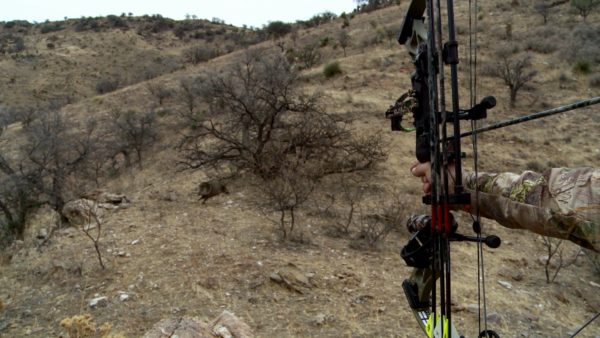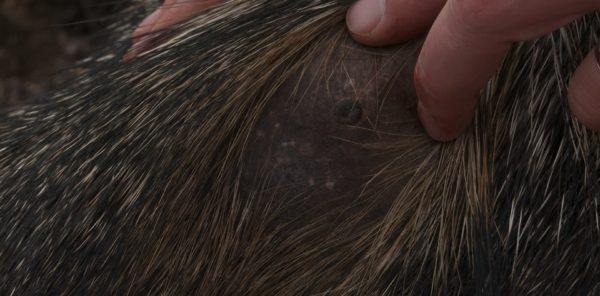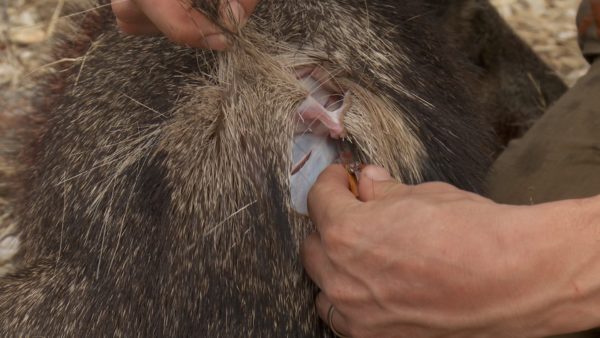
Most big game animals have plenty of fanatics. These are guys who devote themselves entirely to the studying and hunting of a particular species, often to the exclusion of all other game animals. Javelina are a notable exception.
While there are certainly a handful of hunters out there who regard themselves as javelina geeks, the species does not inspire widespread devotion. Most hunters who live in javelina country regard the animals as something of a novelty species that’s unworthy of serious consideration.
They say that javelina are small, they are not particularly hard to hunt, they are not particularly great to eat, and they don’t have awesome-looking horns or antlers that you can hang on a wall. But the hunter who turns up his nose at javelina is missing out on one of the most thrilling and unusual hunting opportunities that North America has to offer.
Thanks to the poor sensory perception of javelina compared to critters such as deer, it’s possible for a careful hunter to literally merge with a group of the animals and get an insider’s perspective on herd behavior before selecting a particular animal for harvest.
Crawling along just yards away from six or seven javelina is a rush, particularly as you listen to their grunts and snarls and smell the fecund stink of their glands. It’s about as up close and personal as you can get as a hunter, and the intensity only grows when you pull out a javelina distress call and blow a few notes. As these critters expose their tusks and come rampaging your way, you’ll experience an unusual sensation that you don’t often get when hunting such critters as deer or elk: it’s called fright.
Scientific Name
Tayassu tajacu
A.K.A.
Collared peccary, skunk pigs. Javelina are one of three peccaries in the New World. The white-lipped peccary ranges widely from southern Mexico into northern South America. The Chacoan peccary ranges only in the Gran Chaco region of Argentina, Bolivia, and Paraguay.
Bar Room Banter
In the United States, javelina can only be found in portions of Arizona, New Mexico, and Texas. It seems that the animals are relatively new arrivals to these areas. Prior to 1700 A.D., they are conspicuously absent from the archaeological record in many areas that now have stable populations. At archaeological sites that are newer than 1700 A.D., however, the bones are much more prevalent.
While this could be taken as evidence of a change in dietary habits among Southwest Indian tribes, it should be noted that javelina are also absent from older-dating pictographs and petroglyphs, which include depictions of many other species that are not commonly eaten.
As a species that experienced a sudden northward extension of its range during the last few hundred years, the javelina is not alone. Raccoons and opossums are two other species that made significant northward movements over the past few hundred years.
Physical Characteristics
Javelina have a strong resemblance to pigs, including a pig-like snout, though they are only distant relatives of pigs. According to scientific understanding, the genetic split between peccaries and pigs occurred some 30-million years ago.
Javelina are colored grizzled gray or black, with a prominent “collar” of lighter colored hair that sits like a yoke between their neck and shoulders. Mature javelina typically weighs between 40 and 60 pounds.
Diet
Javelina are classed as omnivores, meaning they will eat both plant and animal matter. While they do occasionally eat bird eggs, grubs, insects, and reptiles, their primary foods sources are desert plants.
Favorites include prickly pear cactus, mesquite beans, sotol, agave, various tubers, and acorns from scrub oak.
Life and Death
Mountain lions, jaguars, and black bears all prey upon javelina. Smaller predators such as coyotes and bobcats generally steer clear of them, perhaps because of the Javelina’s incredibly sharp tusks and they can be tenacious fighting spirit.
Breeding and Reproduction
Javelina can and will breed year-round, though most litters are dropped in the summer. Litter sizes vary from two to six offspring, with twins being most common.
Habitat
Desert country, ranging from rocky desert scrub to desert grassland.
Telltale Sign
Evidence from feeding includes chewed paddles of prickly pear cactus, shredded sotol and agave plants, rooted-up ground, and overturned cow pies. Bedding locations can often be found beneath rocky overhangs or in thick brush that provides shade. Javelina can also be detected by their powerful, musky odor.
Edibility
Probably the least regarded of all North American big game animals. Javelina have a potent scent gland on their lower back; contamination from this gland can give the meat a nasty taste. With careful field care, though, javelina meat is quite passable.
Best used for such slow-cooked and/or heavily seasoned preparations that one might use on an old wild boar. Think chorizo, shredded barbeque, and brined and smoked hams.
Hunting Opportunities
Arizona offers the best opportunity for public- land javelina hunting. Non-residents and residents alike have to apply for javelina tags, but leftover tags are available every year. There, javelina are hunted in the spring. While West Texas has a great many javelina and readily available tags, it is short on public land.
Hunting Methods
In terrain that affords you a vantage point with clear views, spot and stalk hunting will provide the most javelina hunting action. When looking for javelina, pay close attention to the weather. Javelina are poorly insulated, as they do not have guard hairs.
On cold mornings that are near or below the freezing point, you might not see any movement until well into the morning, as the animals will be huddled up for warmth. When they do emerge, they will likely choose areas that receive direct sunlight. During hot days, on the other hand, their daylight movements might be restricted to the first and last few minutes of the day.
The animals will also avoid the heat by hanging around in the bottoms of deep, shaded canyons where they can be difficult to locate by a spot-and-stalk hunter who’s perched up on a high vantage point.
Javelina are fairly predictable in their patterns. Left undisturbed, a herd of the animals might spend days or weeks within a small area that can be glassed from one position. If you spend all day looking and only catch a glimpse of a distant javelina, don’t disregard the sighting as a fluke.
Glassing Javelinas
There were probably multiple animals with the one you saw, and you will probably find them again if you keep hanging around the area. If necessary, move closer to where you saw the javelina and concentrate your efforts on likely habitats within that zone.
When glassing, keep in mind that javelina are small, dark, and low to the ground. Hillsides covered in prickly pear are great areas to find them, but don’t expect to see an animal rising obviously above the cactus palms. Instead, you’re looking for a critter that can be difficult to spot when it’s holding still.
Nine times out of ten, you’ll spot a herd because you detected movement. But don’t rule out the possibility of seeing javelina that are either bedded or standing still. Take time to examine any strange shapes or dark patches. If a shape can’t be ruled out as a potential javelina, watch the area around it for the movement of other animals.
Javelina are seldom alone; when six or seven of them are lounging around together, one of them is bound to fidget or scratch or get up to take a piss before too long.
Stalking Javelinas
When you find a group, you can go after them pretty hard as long as you stay downwind and don’t approach within a couple hundred yards before switching to stalk mode. Their vision is not great, but don’t mistake them for stupid. If you startle them, they will scatter and clear out.
Javelina have low sexual dimorphism, which means that the males and females are similar in form. It’s difficult for an inexperienced javelina hunter to look at a herd and pick out the males. Since javelina can breed year-round, make sure that your targeted animal does not have offspring. The youngsters will usually stay quite close to their mother, often traveling directly in her wake.
For the maximum chance of getting a mature, large-bodied animal, try to compare the body sizes of the various herd members to get a relative idea about each animal’s body size. Pick the biggest one and go for it.
Stalking Tips
It’s hard to do spot and stalk hunting in flat desert country with thick vegetation. You just can’t see enough ground to make it worthwhile. In these areas, the best option is to slowly cover ground on foot in search of javelina and javelina sign. The animals can be pretty much anywhere, but it’s good to concentrate your efforts around canyon bottoms and dry washes where tracks from the animals can be most readily identified.
By locating fresh tracks, you can “shrink” the desert down to a few likely areas and then concentrate your efforts in more probable locations. It’s especially advantageous if you can hunt after a rain, when all of the old tracks have been washed away.
This way, if you hit some very fresh tracks, you can slowly follow the animals and will likely catch up to them as long as they continue to travel on soft surfaces that will reveal tracks.
Smell First
At all times, pay attention to your nose and ears as much as your eyes. Javelinas have a unique odor and you might just smell them before you see them. They are also quite vocal; on occasion, the location of a herd is betrayed by the sound of grunts and snorts coming up from the bottom of a canyon. It’s also possible for a javelina’s location to be given away by the sound of its chewing.
When three or four of the animals are ripping into prickly pear, it makes a lot of racket. Finally, make sure that your binoculars get a lot of use. Because javelina are so difficult to spot in thick scrub, you should be vigilant about dissecting the surrounding cover with your binoculars as you creep along.
An alarmed javelina will often freeze in its tracks and watch for the source of a disturbance. If you can identify them before they identify you, you might be able to make a quick shot before they take off. But when shooting in thick cover, make sure to carefully verify your target and ascertain whether or not another javelina is standing behind the one you’re aiming at.
A bullet can easily pass through one Javelina into another, killing both. There is no need to make a hasty shot; if the herd spooks, you should be able to find it again over the next couple of days if you’re diligent about looking.
Under the right circumstances, javelina will respond more dramatically to a game call than any other species of big game. Appropriate javelina calls mimic the sound of a distressed and frantically struggling javelina. An excellent javelina call is the J-13 Javelina Call, by Arizona Predator Calls.
Such calls will not bring in javelina from great distances, but they can be extremely effective if blown within 75 or so yards from a herd of javelina. In some respects they work almost too well, as many hunters are so dumbfounded by the sight of a charging herd of javelina that they fail to make a shot before the javelina spook and vanish.
The most effective use of a javelina call is to locate a herd of javelina and then stalk to within 75 yards of the animals without alerting them to your presence. Then, before blowing the call, you should get your bow or firearm ready for action. Start out with a short burst of frantic calls lasting about 5 seconds. If the javelina are going to respond, they will likely do so immediately. Sometimes the animals will charge right past you while clacking their teeth and whoofing; if you don’t get a shot, you might bring them around for a second pass with continued calling.
If you blow your initial call and the herd spooks immediately in the opposite direction, stop calling. They may have been “educated” by a previous hunter using a similar call. If so, let the herd calm down and return to normal before you attempt another stalk. Javelina calls can also be used to turn around a bad situation. If you accidentally stumble into a herd and send the animals clattering off into the brush, a quick sequence of calls might bring herd members who are unsure about the source of the trouble charging back in your direction. There’s a very good chance that the call will not work in this situation, but it’s worth a try since the animals were already spooked in the first place.
Removing Javelina Scent Glands
Centered on the lower back of the animal, a javelina’s scent gland bears a strange resemblance to a human breast. Musk from the gland can contaminate the taste and smell of the animal’s, so it should be removed before you begin the butchering process.
After cutting a circle around the gland that goes all the way through the hide, you can simply skin the gland away and discard it. Rinse your hands and cutlery before continuing with the butchering process.








Conversation